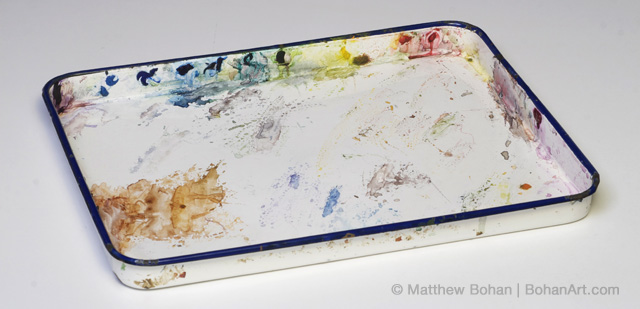
I’ve used a variety of palettes over the years. While you could use virtually any waterproof white surface, I’ve found that not all are created equal. In the end, I’ve found that its best to have a few to choose from!
The most important qualities of a good palette are that it is pure white, large enough to mix all your colors and easy to clean.
The handiest palette that I own is a 13 x 17 inch enameled butcher’s tray with sides that are about an inch tall. It is indispensable, and it’s my go-to palette about ninety percent of the time. By squeezing the colors out high on the sides, I can grab color and mix my pigments on the tray’s surface. The colors are high enough that I can run a damp sponge along the bottom to clean off the mixing area without wiping away the fresh pigment stashed high on the sides. This saves the fresh pigments, and as much as I love Winsor & Newton’s Artist’s Series tube watercolors, they aren’t cheap!
Although a big tray like this takes up working space, having a large, pure white mixing surface is ideal. The large size also encourages you to mix a decent-sized amount of pigment, adjusting the color of just a portion of it. Finding the right color just seems easier with this type of palette. I can easily re-wet areas that have dried up.
On pure white surfaces you can judge the color really well. Occasionally you’ll see palettes that are off white. It is almost impossible to determine color accurately on these, especially with transparent watercolor. Material is important, too. Enameled metal and porcelain make ideal mixing surfaces because they clean off so easily. Some plastics have a tendency to get small pits and scratches in them as time goes by. These retain pigment and therefore don’t remain pure white. Plastics often stain when used for mixing pthalocyanine pigments. Once this happens, judging color becomes more difficult. A good alternative to the butcher’s tray is a pure white porcelain plate, which you can get for next to nothing at Goodwill or a garage sale.
One task where the butcher’s tray fails is mixing up a lot of paint for a larger wash. The flat, oversized tray just wants to make a big, messy puddle. I switch to a round porcelain-welled tray for these mid-sized jobs. For mixing very large washes I have some small 5-6 oz. porcelain cups. Having a few on hand is a good idea, especially if you are doing a large background with a gradient. When mixing in deeper containers, it is harder to judge color accurately. Colors always look darker because of the added depth. Once spread thin all over the paper, that same color looks a lot lighter. When mixing in cups or bigger wells, I always test the color on some scrap watercolor paper so see exactly what I’m going to get.
In the end, finding supplies that work for you is the critical part.

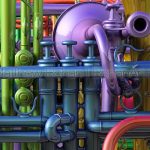
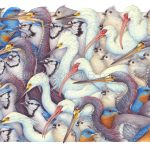
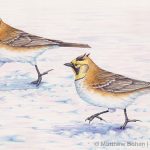
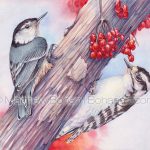
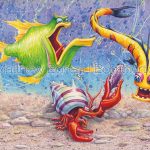
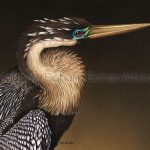
Angela Korniotes
Where can I get a FLAT bottomed enamel butcher tray????
Matt
Mine are both over 20 yrs old, so I’m not 100% sure where to get a truly flat bottomed one. Mine are. Some of them do have slightly bowed bottoms so the fluids collect at the edges for easier pouring if you are actually using them for cutting meat.
I have two one with a taller 1 inch lip and another with a 1/2 inch lip. I prefer the shorter one. Jerry’s artarama has some:
Reviews, comments and descriptions didn’t talk about the bottoms though.
https://www.jerrysartarama.com/butchers-tray-palettes
Amazon’s didn’t get exactly rave reviews!
https://www.amazon.com/Pro-11-Inch-15-Inch-Butcher-Tray/dp/B0027ACHGG/ref=sr_1_2?s=home-garden&ie=UTF8&qid=1536457242&sr=1-2&keywords=butcher%27s+tray